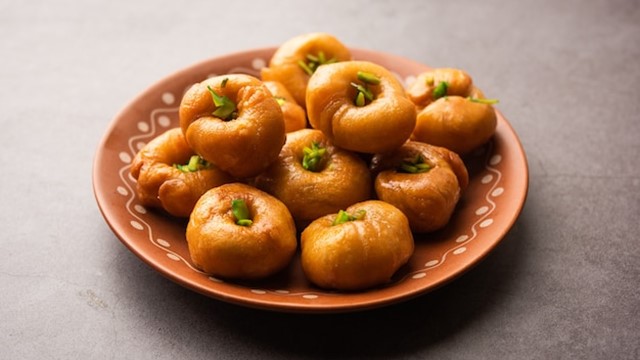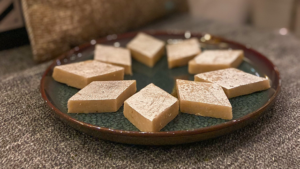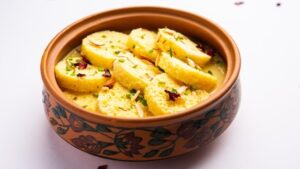Introduction:
In the rich tapestry of Indian desserts, few treats embody the essence of indulgence and tradition quite like balushahi. With its delicate layers of flaky pastry soaked in sugary syrup, this beloved sweet has been enchanting taste buds for centuries.
Indulge in the rich heritage of Indian sweets with our comprehensive guide to balushahi, a traditional delicacy cherished for its flaky texture and sweet, syrupy goodness. In this article, we delve into the origins, ingredients, preparation, and cultural significance of balushahi, offering insights into why this timeless treat continues to captivate dessert lovers across generations. From its humble beginnings to its modern-day variations, discover the artistry and craftsmanship behind every bite of this beloved confection. Join us on a mouthwatering journey as we unravel the secrets of balushahi and celebrate the sweet traditions that have stood the test of time.s we embark on a delectable journey to uncover the history, ingredients, preparation, and cultural significance of balushahi.

Origins and History:
Balushahi, a delectable sweet treat cherished in Indian cuisine, has a rich history that spans centuries and continents. Its origins can be traced back to the cultural exchange between Persia (modern-day Iran) and the Indian subcontinent, particularly during the Mughal era.
The name “balushahi” is believed to have Persian roots, derived from the Persian word “bālushāhī,” which translates to “king of sweets.” It is said that the Mughal emperors, who were known for their love of extravagant feasts and luxurious delicacies, were introduced to balushahi through Persian culinary influences.
During the Mughal period in India, which lasted from the 16th to the 19th century, Persian artisans and chefs brought with them a rich culinary heritage that blended seamlessly with local ingredients and techniques. Balushahi emerged as a result of this cultural fusion, combining Persian confectionery techniques with Indian ingredients and flavors.
Over time, balushahi evolved into a beloved sweet treat enjoyed by people of all backgrounds across the Indian subcontinent. It became particularly popular during festivals, weddings, and other special occasions, where it was often served as a symbol of sweetness, prosperity, and hospitality.
While its exact origins may be shrouded in the mists of history, balushahi’s enduring popularity speaks to its timeless appeal and cultural significance. Today, this exquisite delicacy continues to be crafted with care and precision by artisans and home cooks alike, keeping alive the traditions and flavors of generations past. Whether enjoyed as a nostalgic childhood treat or discovered as a new culinary delight, balushahi remains a cherished symbol of India’s rich culinary heritage and cultural diversity.
Cultural Significance:
Balushahi holds significant cultural importance in India, deeply ingrained in the country’s culinary traditions and social customs. Here are several ways in which balushahi is culturally significant:
Celebrations and Festivals
: Balushahi is often associated with joyous celebrations and festive occasions in Indian culture. It is a popular sweet served during festivals such as Diwali (the Festival of Lights), Eid, Raksha Bandhan, and weddings. Its presence on these special occasions symbolizes happiness, prosperity, and togetherness.Hospitality
: Offering sweets to guests is a common practice in Indian culture, and balushahi is frequently included in hospitality gestures. Whether welcoming guests into the home or presenting gifts during festive gatherings, serving balushahi reflects warmth, generosity, and hospitality.Religious Significance
: In addition to festivals, balushahi plays a role in religious rituals and ceremonies. It is often offered as prasad (a religious offering) in temples and distributed among devotees as a blessed food. The act of sharing balushahi during religious observances fosters a sense of community and devotion.Regional Variations
: Across different regions of India, variations of balushahi exist, each with its own unique flavors and preparation methods. These regional variations highlight the diversity of Indian cuisine and the influence of local ingredients and culinary traditions. Whether it’s called balushahi, badusha, or makkhan vada, this sweet treat remains a beloved favorite across the country.Artisanal Craftsmanship
: The making of balushahi requires skill, patience, and attention to detail, often passed down through generations within families or artisanal communities. The craftsmanship involved in preparing balushahi reflects the dedication to preserving culinary heritage and the artistry of traditional sweets.Symbol of Sweetness and Prosperity: Balushahi’s decadent taste and luxurious appearance make it a symbol of sweetness and prosperity in Indian culture. It is often associated with auspicious beginnings, such as the start of a new year or the birth of a child, signifying hope, abundance, and good fortune.
In summary, balushahi is not just a sweet treat; it embodies the cultural richness, social customs, and festive spirit of India. Its presence in celebrations, religious rituals, and everyday life underscores its deep-rooted significance in Indian culinary traditions, making it a cherished symbol of sweetness, hospitality, and togetherness.
Ingredients:
The key ingredients that define the decadent allure of balushahi include:
- Maida (All-Purpose Flour): The base of the flaky pastry, maida is combined with ghee or oil to create a crumbly dough.
- Ghee: Clarified butter adds richness and flavor to the dough, contributing to the buttery texture of balushahi.
- Yogurt: A small amount of yogurt is added to the dough to tenderize and leaven the pastry, resulting in a light and airy texture.
- Baking Powder: Baking powder helps the pastry puff up during frying, creating layers of flakiness.
- Sugar Syrup: Made with sugar, water, and flavored with cardamom or saffron, the syrup is soaked into the fried pastries, imparting sweetness and moisture.
Preparation:
The process of making balushahi is a labor of love that requires precision and patience. Here’s a simplified overview of the preparation:
- Prepare the Dough: Maida, ghee, yogurt, and baking powder are combined to form a stiff dough. The dough is rested to allow the gluten to relax.
- Shape and Fry: The dough is divided into small portions, shaped into rounds, and flattened slightly. These discs are then deep-fried until golden brown and crispy.
- Soak in Syrup: The fried pastries are immediately immersed in warm sugar syrup, allowing them to soak up the sweet liquid and become moist and flavorful.
- Garnish (Optional): Balushahi can be garnished with chopped nuts such as pistachios or almonds for added texture and visual appeal.
Variations and Regional Flavors:
Variations of balushahi exist across different regions of India, each offering unique flavors, textures, and preparation methods. Here are some notable variations and regional flavors of balushahi:
North Indian Balushahi:
- North Indian balushahi is characterized by its flaky texture and generous use of sugar syrup. The dough is typically made with all-purpose flour (maida), ghee, yogurt, and baking powder.
- The fried pastries are soaked in warm sugar syrup flavored with cardamom or saffron, imparting a rich and aromatic sweetness.
- This version of balushahi is often garnished with chopped nuts such as pistachios or almonds for added texture and visual appeal.
South Indian Badusha:
- Known as badusha in South India, this variation of balushahi is similar in preparation but may differ slightly in flavor and texture.
- South Indian badusha is often flavored with cardamom and sometimes garnished with saffron strands or nuts.
- The texture of South Indian badusha may be softer and less flaky compared to its North Indian counterpart, offering a slightly different mouthfeel.
Eastern Indian Balushahi:
- In regions like West Bengal and Odisha, balushahi is known as “bālushāhi” and may have its own distinct preparation method and flavor profile.
- Eastern Indian balushahi may be slightly softer and less flaky than versions found in other parts of the country.
- It may also be flavored with unique ingredients or spices indigenous to the region, reflecting local culinary preferences.
Regional Variations:
- Beyond these main variations, each region of India may have its own local twists on balushahi, incorporating ingredients and techniques specific to the area.
- For example, in Rajasthan, balushahi may be prepared with a hint of saffron or rose water for added fragrance, while in Gujarat, it might be slightly less sweet and more delicate in flavor.
Modern Interpretations:
- With changing tastes and culinary innovation, modern interpretations of balushahi may incorporate creative flavor combinations and presentation styles.
- Some chefs may experiment with infused syrups, exotic spices, or alternative sweeteners to offer contemporary twists on this classic sweet.
Overall, the variations and regional flavors of balushahi showcase the diverse culinary landscape of India, each version offering a delightful taste of local traditions and ingredients. Whether enjoyed in the bustling streets of Delhi, the serene backwaters of Kerala, or the vibrant markets of Kolkata, balushahi remains a beloved favorite that continues to captivate dessert lovers across the country.




